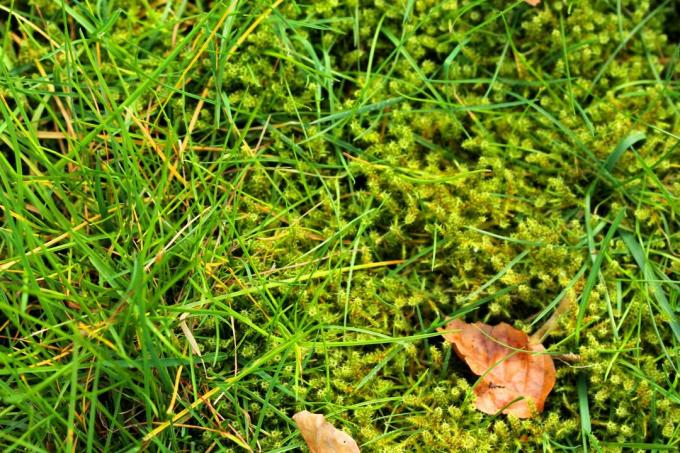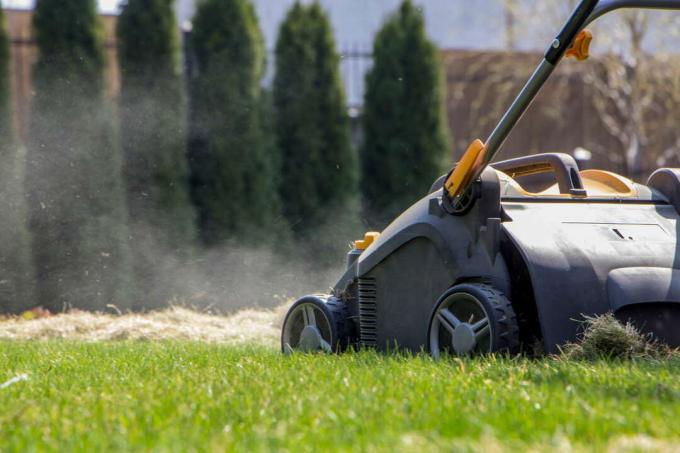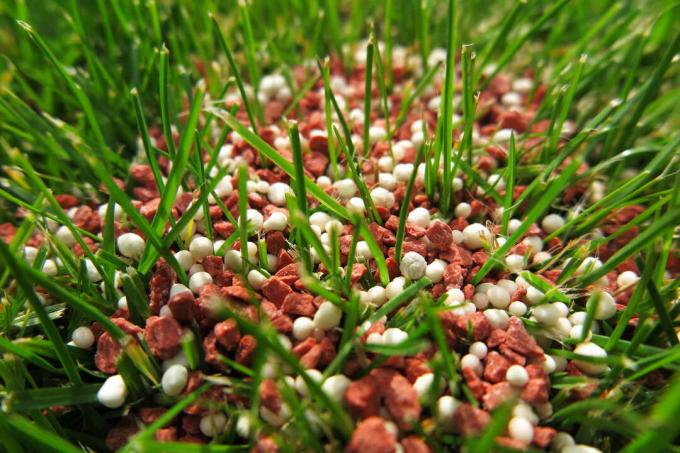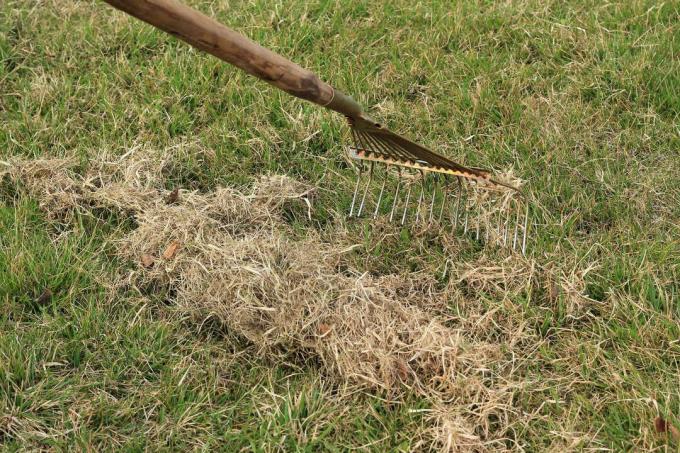Although moss offers a soft surface for walking barefoot, it is rather undesirable in the lawn. We show you how to successfully remove moss from your lawn.
While moss in the lawn feels nice to walk across barefoot, it does cause some problems for the lawn. Moss develops in sparse turf if the lawn does not have ideal growth conditions. Once there is a nice layer of moss on the lawn, the soil conditions for the lawn will become progressively worse. The air and water permeability of the soil is reduced and the grass roots are less supplied with the vital elements of air and water.
contents
- Moss in the lawn: the causes
-
Moss in the lawn: prevention and avoidance
- Lawn seed selection
- Proper lawn care and lawn fertilization
-
Moss in the lawn: remove and fight successfully
- 1. Moss in the lawn: scarify and aerate
- 2. Lime against moss in the lawn
- 3. Moss in the lawn: fertilize properly
- 4. Fertilize with compost
- 5. Regularly sand heavy soils against moss
- 6. Moss in the lawn: mow properly
- 7. Moss destroyer against moss in the lawn
Moss in the lawn: the causes
Mosses always spread when grasses are dormant (i.e. from autumn to spring) or weakened. Poor growth conditions for lawns, such as shade, compaction, lack of nutrients or poor soil permeability offer mosses a growth advantage. Moss is not in itself an invading enemy, but the symptom of neglected lawns. Encouraging lawn growth and the ideal soil conditions for it is therefore the best way to prevent and control moss.

The most common causes of moss formation:
- Rainy weather periods
- waterlogging
- Lack of nutrients in the soil
- Acidic soils (pH below 5)
- Compacted soils
- Shady locations
In very few cases is it just one of these factors that favor the formation of moss. Often, several of the causes mentioned work together and create conditions that are unfavorable for grasses and favorable for mosses.
Moss in the lawn: prevention and avoidance
According to the motto "prevention is better than cure", it is easier to take preventive measures against moss than to fight a heavy infestation.
Lawn seed selection
The fact that mosses are often found in shady, compacted or very loamy locations is often due to the competitive power that most grasses lack under these circumstances. They don't feel comfortable there and are weakened. Gaps appear in the turf all the faster, which the moss then fills in. Grass species that are specially adapted to shady or wet meadows are more competitive and ensure that moss takes hold less quickly or not at all. Therefore, use seed mixtures for the lawn that are specially designed for shadow lawn are suitable like ours Plantura shade lawn. For example, meadow grass (Poa supina) also grows wonderfully and competitively in shady locations.
Even with very heavy soil, it is worth looking for grasses that are adapted to it. Before laying a new lawn, the soil should also be prepared well, for example with drainage in the case of heavy soil. This helps to prevent both moss and weed infestation.
Proper lawn care and lawn fertilization
Will he Properly maintained lawn and fertilized, an excessive spread of mosses can be prevented. This also includes regular mowing, because tall grass means that the surface of the ground dries less easily and thus promotes moss. Regular care is also part of good care fertilizing the lawn, for example with ours Plantura organic lawn fertilizer. It strengthens the grass and prevents patchy turf.
Moss in the lawn: remove and fight successfully
If the lawn already has a soft moss fluff, there are several ways to remove it:
1. Moss in the lawn: scarify and aerate
This is the most important mechanical measure against moss scarifying the lawn. The floor is scratched a few centimeters deep and the moss and floor felt are removed. The grass roots take minimal damage. After scarifying, the moss is removed from the grass and, in the case of heavy moss infestation, scarified a second time. After scarifying, it is overseeded and fertilized at the same time. When overseeding, use seeds that are specially adapted to the location to prevent moss infestation again.

2. Lime against moss in the lawn
Acidic soil alone will not cause moss infestation. Often the low pH is the result of impermeable soil. In any case, grasses cope less well under acidic conditions than moss, which can therefore spread undisturbed under acidic conditions. Before using lime as a moss repellent, be sure to test the pH of your soil. If this is below 5, you can lime. After liming, the pH should be at best 6 – 6.5, at most 7. If the pH value of your soil changes drastically as a result of liming, for example if the pH value has increased from 4 to 6.5, the moss infestation may disappear completely for a short time. Moss is very sensitive to changes in pH.
Caution: However, the disappearance of the moss should under no circumstances tempt you to start liming again the next time you get moss. This could eventually lead to the pH being too high for the grasses. The pH value should therefore be tested before each liming.
3. Moss in the lawn: fertilize properly
Lawn likes nutrient-rich soil – moss, on the other hand, gets along well with poor soil. In order to strengthen the lawn grasses, they are regularly supplied with nutrients in the form of fertilizer. Since moss infestation is particularly favored in the cold season and in the end of winter, it is best to prevent it with a potassium-rich herb autumn fertilization in front.

4. Fertilize with compost
In heavy and wet soils, fertilizing with compost can help improve soil structure. Compost can either be mixed with sand and worked into the lawn with a rake or a few weeks after sanding. Adding compost fertilizer during overseeding is also highly recommended. One to five liters of fine compost per square meter are worked into the existing lawn with a rake. The compost does not cover the surface of the soil or the sown lawn seeds by more than one cm. At best, it rains shortly after composting.
5. Regularly sand heavy soils against moss
In order to improve the air and water permeability of the soil and thus create ideal growth conditions for grasses, heavy soils are sanded once or twice a year. Lawn sanding is therefore a typical method of combating the causes of moss. On slightly sandy soils, spread 3 l sand/m2. For very loamy soils 5 l/m2. The grain size of the sand should be between 0.06 and 2 mm.
6. Moss in the lawn: mow properly
Even if it's annoying, the rule applies: Frequently Cut the lawn with little loss of mass is better tolerated by the lawn and maintains its competitive edge against moss and weeds. The more frequently you mow, the denser the turf and the harder it is for moss to nest between the grasses. In order to make the lawn strong against moss, it has proven itself to mow only a third to a maximum of half of the lawn length. Utility lawn that is to be cut to four and a half to six cm is mowed at a length of seven and a half to a maximum of eleven cm.
By the way: Decorative lawns are mowed more frequently and shorter, shaded lawns less deeply.
7. Moss destroyer against moss in the lawn
If the mechanical removal of the moss with the scarifier is unsuccessful, a so-called moss destroyer can be used in an emergency. Compared to weed killers, ferrous sulfate is a relatively environmentally friendly active ingredient that kills the moss. Before treatment, the lawn is mowed to a depth of four centimetres. Ferric sulfate kills the moss in about two weeks. The lawn is then scarified and leveled to remove the dead moss. In most cases, after scarifying, overseeding is done to close bare spots in the lawn. It is better to wait a few weeks after using moss killers, as these agents can have a germ-inhibiting effect.

Proper watering is an important maintenance step for lawns. When and how to Properly watered lawn, you will learn in this article.



